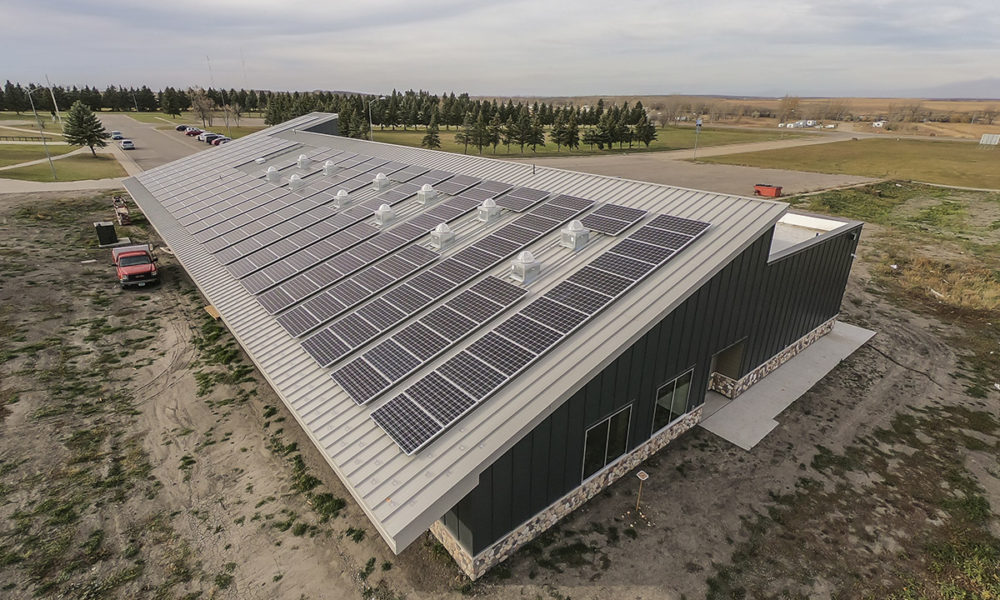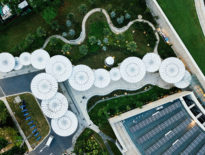As a registered project for Zero Energy Certification with the International Living Future Institute (ILFI), Fort Totten Public Schools is developing a net zero energy educational facility at the Four Winds High School that will receive an independent audit of its energy performance through ILFI. Zero Energy Certification delivers third-party verification of proven performance for the world’s leading projects, which requires a commitment to best-in-class energy efficiency, advanced construction practices and renewable energy installations to power a building’s operational demands over a 12 consecutive month period, post-occupancy. Working with ILFI program staff to discuss best practices for net zero energy design and construction throughout the certification process, registered projects like the Fort Totten CTE School are eligible to schedule calls with the project team to coordinate Zero Energy performance goals, manage documentation requirements for certification, and work collaboratively to streamline the project’s Zero Energy Certification.
The Fort Totten Public School construction completed in August of 2017 was the first of its kind on tribal land, a school with the goal of being net zero. The new 12,500 square foot, career technology education facility is located adjacent to the Four Winds Community School on the Spirit Lake Reservation in North Dakota. The school was funded in November 2015, by the Department of Education, under Impact Aid Program grant for emergency replacement of the existing building, condemned due to water and mold. It expands the educational experience that students have by offering alternative and vocational programs. It includes classrooms, lab space for six teachers, bathrooms, storage areas, and offices.

“Our main goal was to get a replacement school on board as quickly as we could for the Fort Totten School District. When we began to discuss the concept of net zero, the school district was very intrigued and wanted to pursue this option if we could control costs to stay within their grant. I’m proud to say we delivered a new replacement school that was Net Zero ready, within their budget,” noted Mike Laverdure, Principal Architect for DSGW. “We were also very thankful for the generosity of the Shakopee Mdewankanton Sioux Community and their grant to purchase the solar panels, making our project net zero.”
The $3.8 million net zero school was designed to produce more energy than it consumes while ensuring to meet other standards common when designing a net zero facility. There are other net zero schools in the United States, but this new school is the first to be built on tribal land and the first in North Dakota.
The features of the building that contribute to its energy efficiency are photovoltaic (solar) panels, a decentralized ground-source geothermal heating and cooling system, high-efficiency water-to-air heat pumps, energy recovery system, variable-speed fans and pumps, occupancy sensors, LED lighting, solar tubes for day-lighting, high R-value roof and walls, and triple pane windows.
The end goal for the building is an Energy Use Intensity (EUI) of 24 (kBtu/ft2/year). The school is currently in its 12 month monitoring period through the International Living Future Institute to attain Zero Energy Certification.
The building envelope was a main concern for the design team, as they were fighting against North Dakota weather and still trying to keep the lowest EUI possible. The team decided on Insulated Concrete Forms (ICFs) by Nudura for the exterior walls and 10-inch Structurally Insulated Panels (SIPs) for the roof. This strategy, along with the triple pane windows were a big factor in attaining the lower EUI.

“The new school expands the educational experience that students have at Four Winds High School by offering an alternative program and career technology education,” stated Jeff Olson, Superintendent of Fort Totten Public Schools. “This building is about the future. We’re not only preparing our students for the future, but we’re also designing this building for the future by using the earth respectfully and efficiently to power the school.”
“This was a huge project for this tribal school district, as the Net Zero status helps them alleviate operational costs into the future. Many tribal schools can find money to build, but have difficulty with operational costs, especially when they continually see budgets shrink from year to year,” Laverdure acknowledged.
DSGW is the architect for this project, Obermiller Nelson Engineering (ONE) is responsible for mechanical and electrical engineering, and Shingobee Builders is the construction manager.
About DSGW Architects
Established in 1938, DSGW is an architectural firm offering planning, design and interior services to communities of every size and character. Its 35-member team has offices in Duluth, Virginia, and Lake Elmo, Minnesota. Over three decades, DSGW has provided services to Native American communities throughout the country. For more information, visit www.dsgw.com.
About ONE
Since 1992, ONE has delivered success to their clients by providing professional, detailed mechanical, electrical and civil building design and coordination. It is a Subchapter S Corporation with seven locations in North Dakota and Minnesota including Alexandria, Bismarck, Duluth, Fargo, Grand Forks, and Minneapolis and also Philadelphia, PA. With licensed mechanical engineers, electrical engineers, civil engineers, fire protection engineers, LEED-accredited professionals, and their commissioning services professionals on staff, ONE provides its clients with the highest quality of engineering services. For more information, visit www.obernel.com.
About Shingobee
Shingobee is a commercial construction and development company, providing general contracting, project management, and real estate services since 1980. With three offices in Minnesota and North Dakota, they work with clients located through the upper Midwest. For more information, visit www.Shingobee.com.



